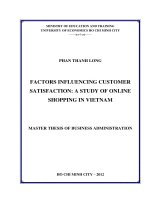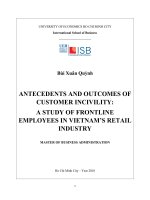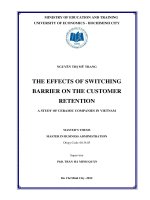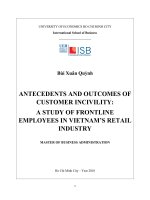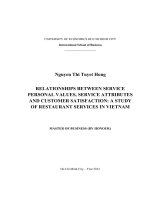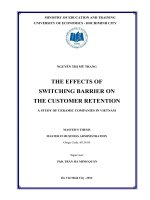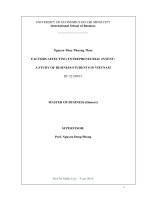Factors influencing customer satisfaction a study of online shopping in vietnam
Bạn đang xem bản rút gọn của tài liệu. Xem và tải ngay bản đầy đủ của tài liệu tại đây (874.33 KB, 97 trang )
MINISTRY OF EDUCATION AND TRAINING
UNIVERSITY OF ECONOMICS HO CHI MINH CITY
------------
PHAN THANH LONG
FACTORS INFLUENCING CUSTOMER
SATISFACTION: A STUDY OF ONLINE
SHOPPING IN VIETNAM
MASTER THESIS OF BUSINESS ADMINISTRATION
HO CHI MINH CITY – 2012
MINISTRY OF EDUCATION AND TRAINING
UNIVERSITY OF ECONOMICS HO CHI MINH CITY
------------
PHAN THANH LONG
FACTORS INFLUENCING CUSTOMER
SATISFACTION: A STUDY OF ONLINE
SHOPPING IN VIETNAM
Subject: Master of Business Administration
Code: 60.34.01.02
MASTER THESIS OF BUSINESS ADMINISTRATION
SUPERVISOR:
DR. NGUYỄN THỊ MAI TRANG
HO CHI MINH CITY – 2012
I
ACKNOWLEDGEMENT
For the successful completion of this thesis, I would like to extend my
sincere thanks to:
Respectful lecturers of University of Economics Ho Chi Minh City,
who have empowered me with considerably useful knowledge during the time
I studied in the University, especially Dr. Nguyễn Thị Mai Trang, who have
whole-heartedly instructed me to approach relevant matters in reality,
research methods, as well as the contents of the thesis.
Students of the eMBA course, University of Economics Ho Chi Minh
City for kindly helping me to collect information necessary for the study. My
special thanks also go to Mr. Cao Quốc Việt for his strong support in the
implementation of the data analysis and the completion of the thesis.
Although the author has tried the best to complete the thesis, but errors
could not be comprehensively avoided. Therefore, the author is looking
forward to receiving the inputs and comments from respectful lecturers and
friends, so that the thesis could be more and more improved.
Phan Thanh Long
Ho Chi Minh, 28 October 2012
II
COMMITMENT
I would like to commit that this thesis, “Factors influencing customer
satisfaction: a study of online shopping in Vietnam”, was accomplished based
on my independent and serious studies and researches. The data was collected
in reality and it has clear origins. In addition to that, the data was trustworthily handled by author and it has never been released in any menu.
Ho Chi Minh, 28 October 2012
Phan Thanh Long
Signature: __________________
III
TABLE OF CONTENT
ACKNOWLEDGEMENT ........................................................................................ I
COMMITMENT ..................................................................................................... II
TABLE OF CONTENT ......................................................................................... III
LIST OF TABLE...................................................................................................... V
LIST OF FIGURE.................................................................................................... V
ABSTRACT ...............................................................................................................1
CHAPTER 1: INTRODUCTION ............................................................................2
1.1. Research background ...........................................................................................2
1.2. Internet development and application of e-commerce in Vietnam ...................3
1.2.1. Advantages of Vietnam online shopping environment .................................4
1.2.2. Difficulties and challenges in Vietnam online market ..................................5
1.3. Problem statement ................................................................................................6
1.4. Research questions ...............................................................................................7
1.5. Research objectives ..............................................................................................7
1.6. Significances of the research ................................................................................8
1.7. Research scope .....................................................................................................8
1.8. Research method ..................................................................................................9
1.8.1. Qualitative method ........................................................................................9
1.8.2 Quantitative method .......................................................................................9
1.9. Structure of the research.......................................................................................9
CHAPTER 2: LITERATURE REVIEW ..............................................................11
2.1. Introduction .......................................................................................................11
2.2. Online shopping customer satisfaction (e-satisfaction) .....................................11
2.3. Proposed conceptual model and hypotheses ......................................................14
2.4. Summary ............................................................................................................18
CHAPTER 3: RESEARCH METHODOLOGY .................................................20
3.1. Research design ..................................................................................................20
3.2. Questionnaire development ................................................................................21
3.2.1. Independent variables ..................................................................................22
3.2.2. Dependent variable Online shopping customer satisfaction .......................25
3.3. Questionnaire translation ..................................................................................27
3.4. Research strategy ..............................................................................................27
IV
3.4.1. Qualitative pilot study .................................................................................27
3.4.2. Quantitative pilot study ...............................................................................28
3.5. Targeted population ...........................................................................................28
3.6. Research sampling .............................................................................................29
3.6.1. Sample size ..................................................................................................29
3.6.2. Sample strategy ...........................................................................................29
3.7. Collecting data ...................................................................................................29
3.8. Methods of data analysis ....................................................................................30
3.8.1. Data cleaning ...............................................................................................31
3.8.2. Reliability assessment of measurement scales (Cronbach alpha) ...............31
3.8.3. Validity assessment of measurement scales (EFA) .....................................31
3.8.4. Multi Linear Regression (MLR)..................................................................32
3.9. Research process ................................................................................................33
3.10. Summary ..........................................................................................................33
CHAPTER 4: DATA ANALYSIS .........................................................................35
4.1. Descriptions of sample ......................................................................................36
4.2. Reliability and validity of the measurement scale ............................................37
4.2.1. Reliability (Cronbach alpha) ......................................................................37
4.2.2. Exploratory factor analysis (EFA) ..............................................................40
4.3. Testing the research model and the hypotheses ................................................46
4.3.1. Testing correlations of constructs...............................................................46
4.3.2. Checking regression assumptions ..............................................................47
4.3.3. Multi-Linear regression analysis ................................................................48
4.4 Summary .............................................................................................................53
CHAPTER 5: CONCLUSION AND IMPLICATION ........................................55
5.1. Discussion of findings ........................................................................................55
5.2. Practical implications .........................................................................................56
5.3. Limitations and recommendations .....................................................................58
LIST OF REFERENCE .........................................................................................60
APPENDIX I............................................................................................................70
APPENDIX 2 ...........................................................................................................74
APPENDIX 3 ...........................................................................................................79
APPENDIX 4 ...........................................................................................................86
GRAPHIC ANALYSIS OF REGRESSION ASSUMPTIONS ...........................86
APPENDIX 5 ...........................................................................................................88
V
LIST OF TABLE
Table 2.1. Summary of existing researches in e-satisfaction .......................... 13
Table 3.1. Survey items used in the study ....................................................... 25
Table 4.1. Statistical report of socio-demographic variables .......................... 37
Table 4.2. Cronbach alpha coefficients ........................................................... 38
Table 4.3. Details of five unqualified observation variables .......................... 42
Table 4.4. EFA results of independent variables ............................................43
Table 4.5. EFA results of dependent variable ................................................. 45
Table 4.6 Correlations ..................................................................................... 46
Table 4.7. MLR results using Enter technique ................................................48
Table 4.8. ANOVA ......................................................................................... 49
Table 4.9. MLR variables coefficients ............................................................ 49
Table 4.10. Results of testing the hypotheses ................................................. 51
LIST OF FIGURE
Figure 2.1. Proposed conceptual framework .................................................. 15
Figure 3.1. Research process in the study ....................................................... 35
Figure 4.1. The updated research model ......................................................... 53
1
ABSTRACT
Vietnam has witnessed rapid development of Internet, in terms of
infrastructure, users and internet-based services. As for Vietnamese people, Internet
gradually becomes a very important channel for shopping, introducing products and
services, characterized by the surging numbers of online transactions. It inspired the
need to study the issues related to the satisfaction of customers for online shopping.
The purpose of the thesis is to study the main factors influencing the
satisfaction of customers when they carry out the online shopping. The study is
based on the data related to online shopping customers of the website ebay.vn over
the past 6 months.
Information quality, Website design, Delivery method, Customer service,
Merchandise attribute were identified as five important factors influencing
Vietnamese customer satisfaction as they purchase online.
2
CHAPTER 1
INTRODUCTION
This chapter will present overview introduction on the development of
Internet, as well as e-commerce applications in Vietnam recently. Research problem,
research objectives, research questions, extent and method of research will also be
presented.
1.1. Research background
The coming into being of Internet has been changing the traditional ways of
purchasing goods of human being. The users have no longer been restricted by time
and geographical factors. They could actively buy the products and goods
regardless of any time and location factors. Internet has brought about new methods
of communication and new ways of exchanging everyday information between
peoples. The ever increasing number of Internet users would also coincide with the
development of online purchasing (Joines, Schere & Scheufele, 2003). The fast
development of Internet would be explained by the combination of broadband
technology and the change of customer behaviour (Oppenheim & Ward, 2006).
Online shopping is a process when users decide to buy products or services
in the Internet economy. Internet was developed as a new channel of distribution
(Hollensen, 2004) and e-commerce was identified by Smith and Rupp (2003) as a
very important factor contributing to Internet revolution. Online shopping is one of
the main reasons for using Internet and looking for goods, as well as information
related to the goods (Joines et al., 2003). Smith and Rupp (2003) also said that
thanks to Internet, users could find many providers and reference information, as
well as reviews of products they need to buy. That is the reason why Internet has
become a very competitive environment, when the fights are very tough to attract
and keep the customers. To influence and keep the customers in a competitive
3
market, Constantinides (2004) found it would be very necessary to identify the
factors or issues influencing customers when they carry out their online shopping.
1.2.
Internet development and application of e-commerce in Vietnam
According to Vietnam NetCitizens report (Chimigo Vietnam, 2011), in 2010,
the number of Internet users in Vietnam accounted for 31% of the total population.
The percentage is similar to some other countries like China, the Philippines and
Thailand. Over the past few years, in comparison with other countries in the region,
we have witnessed rapid development of Internet in Vietnam and Vietnam becomes
a country whose Internet development ranked top of the world.
In the urban areas (including 12 cities mentioned in Chimigo Vietnam,
(2011)), over 50% of urban population had their Internet connections. The
percentage was even higher in Ha Noi and Ho Chi Minh city. Online shopping and
auction websites were not regularly used. However, we have witnessed strongest
development of online shopping activities over the past 3 years.
According to information publicized in the Vietnam E-commerce report
2011 by Ministry of Industry and Commerce, 100% of surveyed enterprises were
equipped with computers, 98% were connected with Internet with different ways, in
which 89% had their broadband technology connections (ADSL). Over 81% of
enterprises used e-mails in their business and manufacturing activities, the number
was 96% for big enterprises and 80% for small and medium enterprises. The
application of specialized software was prioritized by enterprises to enhance the
efficiency of their activities, such as accounting (88%), human resource
management (48%)… Most of enterprises accepted the bookings or made the
bookings via electronic devices, in which the number of enterprises accepted the
bookings or made the bookings via Internet was ever increasing. According to the
survey, the percentage of enterprises accepted the bookings via e-mails accounted
for 52% and the number was 15% for website-based bookings, the percentage of
enterprises made the bookings via e-mails accounted for 53% and the number was
4
21% for website-based bookings. The enterprises were also aware and paid much
more attention to particular issues related to e-commerce, such as the security of
information and individual information. In addition to that, enterprises paid very
much attention to the development and promotion of their images and products in
the Internet environment by developing their own websites; participating in ecommerce portals, social networks; advertising in e-newspapers and famous
searching engines like google.com, yahoo.com… Statistics showed that 38% of
enterprises developed their own websites, 14% participated in e-commerce portals.
1.2.1. Advantages of Vietnam online shopping environment
Thanks to the rapid development of Internet in Vietnam, both in terms of
infrastructure and number of users, e-commerce of Vietnam becomes very potential,
attracting many enterprises and individuals selling their services and products to
participate in the market for online shopping. In addition, Vietnamese users are
becoming more familiar with online shopping activities provided by domestic and
oversea websites. Over the past few years, online shopping enjoys strongest growth
rate in comparison with other businesses. According to the report carried out by
Chimigo Vietnam (2011) in Vietnam NetCitizens report, online shopping volume
was doubled since 2007.
Vietnamese customers are also more familiar with electronic payment
systems, which is a very important factor of online shopping. At the present
moment, customers have many options to choose the electronic payment gateways
when they purchase online. Some payment gateways are highly trusted becoming
popular, such as NganLuong, BaoKim, VNPay, Payoo, OnePay… Thanks to the
development of these electronic payment gateways, Vietnamese individuals and
enterprises could easily develop Internet-based websites selling and buying products
and services. The selling process is automated in a higher level as transactions could
be totally completed online, replacing the previous method in which the products
are introduced in the Internet and the cash is collected after the delivery of product.
5
Many big foreign companies are looking for business opportunities in the ecommerce market of Vietnam. Some of the big names in the world, such as Google,
Alibaba, Rakuten, eBay and Amazon, quickly promote their appearance in the
market. In June 2012, Google became member of Vietnam E-commerce
Association and had their plans to develop online shopping activities with other
members. They expected that they could earn 30 millions USD per year in Vietnam
market, in which their potential customers are small and medium-sized enterprises.
The official representative of Alibaba was announced while eBay just bought
20% of Peacesoft Solution’s shares, who is the owner of the website chodientu.com.
Amazon already approached domestic e-commerce service providers to explore the
opportunities to buy the shares or become their partners. This would be the catalyst
for the development of Vietnam e-commerce.
1.2.2. Difficulties and challenges in Vietnam online market
Although the number of Internet users is huge and ever increasing, the
majority of them only use Internet to look for information and communications
(Vietnam NetCitizens, 2011). Internet plays an important role in choosing and
buying the products, but the trust is still low for online payment methods, because
only a small proportion number thinks that online shopping is secured. Also
according to this study, buying Internet-based products is still not popular in
Vietnam. Only a small number of Internet users regularly log in to online shopping
and auction websites. Most of them agree that “it is possible to buy numerous
products in the Internet”, but many do not think that “online shopping is secured”.
60% do not trust online payment systems.
The other obstacle is low awareness of Vietnamese people and the
unfriendliness of the social environment and business practices. Although
enterprises are very active in applying information technology and e-commerce,
more time spans and necessary steps are needed to achieve advanced business and
consumption environment.
6
Online security and privacy is still not ensured. It shows a fact that
enterprises are aware of the importance of online security for the application of ecommerce.
The legal corridor is not yet fulfilled. The delivery and transportation
services are still weak. The quality of human resources is not as good as
expectations. The online payment systems are under developed. These factors are
considered as other obstacles of the development of Vietnam e-commerce in the
meantime.
1.3. Problem statement
The appearance of millions of Internet users at any time would provide
potential customers for online retailers. Thanks to the development of internet-based
technologies, online shopping websites could discover many opportunities to
approach a great number of customers at anytime and anywhere, but obstacles also
appear as the buyers could easily look for information and choose to buy the
products from many other competitive websites simultaneously. To survive and
develop in the competitive market of online shopping, it is a task for retailing
websites in Vietnam to attract potential customers while retaining their own
customers. Online sellers are requested to understand what Vietnamese customers
want and need when they purchase online.
The importance of analyzing and identifying factors influencing the
satisfaction of customers when they purchase online is very decisive for online
shops running in the e-commerce market of Vietnam. As there are significant
differences between the satisfactions of customers purchasing on the Internet and in
the traditional ways, in the meantime the studies concerning the satisfactions of
customers purchasing online in Vietnam are still limited. It becomes an imperative
demand of online retailers to understand the main factors influencing the
satisfaction of Vietnamese online customers.
7
1.4. Research questions
This research aims to answer the following questions:
-
What are the main factors influencing the satisfaction of Vietnamese
customers when they purchase online?
-
How do these factors influence the satisfaction of Vietnamese customers
when they purchase online?
1.5. Research objectives
This study is conducted to identify factors influencing customer satisfaction
towards online shopping in Vietnam. It seeks to examine and understand whether
factors such as information quality, security and privacy, website design, delivery
method, customer service, merchandise attribute influent consumer satisfaction
when they purchase online. The specific objectives are:
-
To examine the relationship between website design and online shopping
customer satisfaction.
-
To examine the relationship between security and privacy and online
shopping customer satisfaction.
-
To examine the relationship between information quality and online
shopping customer satisfaction.
-
To examine the relationship between delivery method and online shopping
customer satisfaction.
-
To examine the relationship between customer service and online shopping
customer satisfaction.
-
To examine the relationship between merchandise attribute and online
shopping customer satisfaction.
8
1.6. Significances of the research
The results of the study are practically meaningful for e-commerce in
Vietnam. Assist managers and traders of Internet-based products/services to master
the main factors influencing the satisfaction of Vietnamese customers when they
purchase online. The results of the study will provide necessary measures to
improve the online shopping satisfaction of customers, help the sellers to keep their
current customers and attract new potential ones, so that they can survive and
further develop in the potential but highly competitive market of e-commerce in
Vietnam.
The study will also enrich necessary knowledge for people who are doing
their e-commerce business in Vietnam, which is very new and lack of official
studies on this field in Vietnam.
1.7. Research scope
The study would focus on the satisfaction of Vietnamese customers when
they purchase online, regardless of the geographical locations of the buyers.
Furthermore, to ensure that the surveyed customers could be able to provide
adequate information for the study, only customers who has purchased online over
the past 6 months close to the day that the study was carried out was chosen to
participate in the survey.
The targets of the study are customers who made purchases for products
introduced in website www.ebay.vn, the partner website of this study. The website
are leading the ranking of Vietnam top online shopping retailers thanks to the great
number of successful transactions and customer visits daily. Therefore, the study is
also applicable for the B2C (Business to Customer) model of online shopping only,
not the others, such as B2B (Business to Business) or C2C (Customer to Customer).
Previous studies carried out in other countries regarding the satisfaction of
customers for online shopping already identified the main factors influencing the
9
satisfaction of customers. In this study, the author would only choose suitable
factors to test with the online market of Vietnam. This seemed to be the most
appropriate choice considering the limitations in both time and resources.
1.8. Research method
Subjects of study are customers who have made online purchases over the
past 6 months. Due to the fact that the study is carried out thanks to the cooperation
and support of PeaceSoft Solutions Corporation, the scope of study is linked with
customers of the top online shopping website of Vietnam which are under the
ownership of PeaceSoft Corporation: www.ebay.vn, regardless of customer’s
geographical locations.
The study was carried out within 2 steps concerning two different methods:
1.8.1. Qualitative method
The author would use the qualitative method by carrying out group
discussions and deep interviews made with 5 students studying in the same course
who had experiences in online shopping. The purpose of this step is to adjust and
amend the translated questionnaire suitable with the subjects and purposes of the
study.
1.8.2 Quantitative method
Quantitative study would be carried out based on the data collected from the
questionnaire established in Step 1. Quantitative study is implemented to evaluate
the scale, verify the theoretical model. The scale is preliminarily tested the
reliability and validity using Cronbach alpha and exploratory factor analysis carried
out by the SPSS 18.0 software. Correlation analysis and multi-linear regression
analysis would be used to test the proposed model and the hypotheses of the study.
1.9. Structure of the research
Chapter 1: Introduction
10
This chapter presents a background of Internet usage and e-commerce in Vietnam.
Introduction chapter will also provide problem statement, the research questions,
research objectives, as well as extent and methodology of the study.
Chapter 2: Literature review and proposed research model
This chapter presents the theories behind online customer satisfaction. It will
discuss results of the previous researches relating to online consumer satisfaction in
order to continue with the identification of the factors that influence consumer
satisfaction when they purchasing online. The research framework and hypotheses
will also be proposed in this chapter.
Chapter 3: Research methodology
This chapter will present how this research has been conducted in order to
collect primary data and reach the objectives of the research.
Chapter 4: Data analysis and results
Analysis is conducted based on the collected data to test the hypotheses and
answer the research questions.
Chapter 5: Conclusions and implications
This chapter will present the conclusions that were drawn from the analysis
of the research. It will also discuss the results; provide practical implication, and
possible directions for future research.
11
CHAPTER 2
LITERATURE REVIEW
This chapter presents the theories behind consumer satisfaction. It will also
discuss online shopping customer satisfaction in order to continue with the
identification of the influencing factors. The research framework and hypotheses
will also be proposed in this chapter.
2.1. Introduction
In the near future, e-commerce is widely believed to continue its growth and
would play an important role in the development of global economy.
Customer satisfaction is a topic that receives utmost attention from studies
concerning online shopping. More and more online business managers realize that
customer satisfaction is significantly important (Mihelis et al., 2001). In the global
level, profits and sustainable growth of any enterprise are closely attached with the
satisfaction and loyalty of the customers (Reichheld and Schefter, 2000). The
increase of customer retention rate would bring about the increase of benefits
(Huffmire, 2001). Rosen (2001) stated that about 30% of revenue of online
shopping websites would be generated from frequent visitors of the websites. The
satisfaction of customer plays the decisive role in establishing the sustainable
relationship with customers (Patterson et al., 1998).
2.2. Online shopping customer satisfaction (e-satisfaction)
The fundamental understanding of relevant factors influencing online
customer satisfaction is very important for e-commerce (MacKinney et al., 2002).
Szymanski and Hise (2000) proved that convenience, website design and financial
security are major factors influencing e-satisfaction, while product information
would have minor impacts on online customer satisfaction. Jun et al. (2004)
identified six factors which are closely linked with e-satisfaction, namely reliable/
prompt response, access, ease of use, attentiveness, security and credibility. Studies
12
of Jun et al. (2004) found that reliable/ prompt response, access, ease of use and
attentiveness would strongly influence online customer satisfaction in the online
shopping environment.
Studies also show that circumstances and behaviors of online shopping are
very different with traditional purchasing carried out in retailing shops (Degeratu et
al., 2000; Lynch and Ariely, 2000; Shankar et al., 2001, 2003; Ranganathan and
Ganapathy, 2002; Heiner et al., 2004) (cited from Liu et al., 2008). It can be
expected that the key drivers of customer satisfaction and retention in the Internet
economy may also be different from those in the traditional economy.
Liu et al. (2008) conducted an empirical study on online shopping customer
satisfaction in China and discovered that information quality, customer service,
website design, transaction capability, security and privacy, delivery, merchandise
attribute and payment are major factors influencing the satisfaction of customers.
While the subject of satisfaction has been discussed extensively in the
traditional retailing literature (Mason and Bearden, 1979; Oliver, 1981; Anderson et
al., 1994; Terblanche and Boshoff, 2001a,b; Johan, 2006; Ofir and Simonson, 2007)
(cited from Liu et al., 2008), the exploration of dimensions and determinations of
satisfaction under e-commerce context is at a nascent stage (Heiner et al., 2004).
Recently, some researchers have started to investigate how the attributes of a
website will influence customers’ satisfaction. These studies have presented various
characteristics as important factors for an effective B2 C e-commerce website;
however, up to now there is no consensus on how this affects online customer
satisfaction (Schaupp and Be langer, 200 ).
Table 2.1 summarizes several previous studies of the determinants of online
shopping customer satisfaction (Cited from Liu et al., 2008).
13
Table 2.1. Summary existing researches in e-satisfaction
Independent
variable
Key references
Dependent variable
Convenience.
- Szymanski and Hise
(2000)
- Kim and Lim (2001)
- E-satisfaction.
- Heiner et al. (2004)
- Liu et al. (2008)
Website design.
- Szymanski and Hise
(2000)
- Heiner et al. (2004)
- Kim and Stoel (2004)
- Hsuehen (2006)
- Liu et al. (2008)
Financial security.
- Szymanski and Hise
(2000)
- Heiner et al. (2004)
- Liu et al. (2008)
Trust.
Assurance.
Reliability.
Information.
- Kim and Stoel (2004)
- Devaraj et al. (2002)
- Kim and Lim (2001)
- Szymanski and Hise
(2000)
- Kim and Lim (2001)
- Consumers’ satisfaction with
internet shopping.
- E-satisfaction.
- Consumers’ satisfaction with
internet shopping.
- E-satisfaction.
- E-satisfaction.
- Shopper satisfaction of apparel
website.
- Customer satisfaction.
- Consumers’ satisfaction with
internet shopping.
- E-satisfaction.
- E-satisfaction.
- Consumers’ satisfaction with
internet shopping.
- Shopper satisfaction of apparel
website.
- Consumer attitudes and
satisfaction.
- Consumers’ satisfaction with
internet shopping.
- E-satisfaction.
- Ballantine (2005)
- Hsuehen (2006)
- Consumers’ satisfaction with
internet shopping.
- E-satisfaction.
- Shopper satisfaction of apparel
website.
- Customer satisfaction.
- Customer satisfaction.
- Liu et al. (2008)
- Consumers’ satisfaction with
- Heiner et al. (2004)
- Kim and Stoel (2004)
14
Merchandise
variety
- Szymanski and Hise
(2000)
- Heiner et al. (2004)
- Liu et al. (2008)
Perceived ease of
use.
- Devaraj et al. (2002)
Perceived
usefulness.
- Devaraj et al. (2002)
Entertainment.
- Kim and Lim (2001)
- Kim and Stoel (2004)
Speed.
Response time.
Transaction
capability.
- Kim and Lim (2001)
- Kim and Stoel (2004)
- Liu et al. (2008)
internet shopping.
- E-satisfaction.
- E-satisfaction.
- Consumers’ satisfaction with
internet shopping.
- Consumer attitudes and
satisfaction.
- Consumer attitudes and
satisfaction.
- Consumers’ satisfaction with
internet shopping.
- Shopper satisfaction of apparel
website.
- Consumers’ satisfaction with
internet shopping.
- Shopper satisfaction of apparel
website.
- Consumers’ satisfaction with
internet shopping.
2.3. Proposed conceptual model and hypotheses
Based on the conceptual model proposed by Liu et al. (2008) regarding
factors influencing online customer satisfaction in China, within the framework of
the study, considering the adaptability with online shopping environment in
Vietnam, the author chose information quality, customer service, website design,
privacy, delivery and merchandise attribute and evaluates influences of these factors
on online shopping customer satisfaction in context of Vietnam. It would be
appropriate concerning the limitation of time and resources of the author while
carrying out this study. Figure 2.1 shows the proposed research model for this
research.
15
Website Design
H1
Security and Privacy
Information Quality
H2
H3
Online shopping Customer
Satisfaction
H4
Customer Service
H5
Delivery Method
H6
Merchandise
Attribute
Figure 2.1. Proposed research model
Information quality: Szymanski and Hise (2000) realized that the customer
satisfaction on online shopping is greatly influenced by the quality of information
attached with the products provided in the website.
Website information is often monitored rather than just read in details.
Useful and reliable information is very important for customers when they get
access to shopping websites (Szymanski and Hise, 2000). Other studies also
identified that information content should be precise, relevant and complete. It is the
role of the online store to provide information of the products, transaction and
services. Higher information quality would result in better buying decisions and
improve the satisfaction of customers (Peterson et al., 1997).
Privacy and security: In comparison with traditional economies, online
customers extend their attentions to the necessity of privacy/ security (Culnan, 1999;
Friedman et al., 2000; Grewal et al., 2004) (cited from Liu et al., 2008). The
16
inadequateness of infrastructure, the lack of trust, concerns about privacy and
security often result in the sale losses (Yianakos, 2002; Grabner-Kraeuter, 2002)
(cited from Liu et al., 2008). Privacy refers to the rights of individuals and
organizations to decide for themselves when, how and to what extent information
about them is to be transmitted to others (Grandinetti, 1996). The lack of privacy on
the websites would make online shoppers worry about the possible reveal of
transactions and personal information (June et al., 2004).
Website design: Previous studies proved that the user-friendliness of the
website interface plays an important role in ensuring the success of trading via
websites. Del Galdo and Nielsen (1999) called upon the improvement of website
appropriateness, because the lack of appropriateness would lead to dissatisfaction of
users and websites could not be successfully developed in a sustainable manner.
Gummerus et al. (2004) defined that user interface is an environment for the
interactions between users and online shopping providers. Srinivasan et al. (2002)
proved that the interaction of e-commerce would be closely associated with the
loyalty of customers. In addition to that, Alam and Yasin (2009) found in their
studies in Malaysia that website design is clearly linked with the satisfaction of
customers. Website design is regarded as a major factor influencing online shopping
satisfaction (Lee and Joshi, 2007). Zhang et al. (1999) evaluated website quality in
the perspectives of satisfaction and dissatisfaction of users. Their results showed
that website design features can be regarded as the hygiene and motivator factors
that contribute to the user dissatisfaction and satisfaction with a website.
Delivery method: The lack of physical interactions between sellers and
buyers is one of the major weaknesses of e-retailers. Massad et al. (2006) proved
that delivery performance is the key factor for keeping customers satisfied with
online shopping stores. Liu et al. (2008) said that the separation between goods
consumption and productions, as well as the delays of goods delivery could be
found in the environment of e-commerce. The delivery delay would have negative
impacts on satisfaction (Liu et al., 2008). Online stores should pay attention to the
17
improvement of customer shopping experience by providing safe, secure, reliable
and low-cost freight services, included by effective delivery options, the prompt
response and update of delivery status, as well as timely delivery as requested
(Massad et al., 2006). Managers of online stores should also help customers to
easily check and monitor the delivery progress. An informed customer is likely to
be a more satisfied customer (Massad et al., 2006).
Customer service: Post-purchase evaluation can be influenced by the
efficiency of logistics and customer service. The most common types of complaints
about Internet transactions include refund and billing disputes, return and exchange
policies, defective products, and poor customer service (Chen and Chang, 2003).
Consumers want careful, continuous, useful communication across geographic
barriers (Lohse and Spiller, 1998). In the e-commerce environment, not only is the
consumption of goods separated from production, thus making it necessary for
goods to be delivered to consumers before consumption, there is also a delay in the
delivery of goods. Delayed delivery may have a negative effect on satisfaction.
Merchandise attribute: merchandise attribute comprise of the diversity and
prices of the products, which are very important for the buying decisions.
Szymanski and Hise (2000) indicate that wider assortment of products may be
attractive to customers and e-satisfaction would be more positive when online stores
offer superior product assortments. Although authors of some previous studies
stated that price sensibility in the online environment could be lower than offline
environment (e.g., Degeratu et al., 2000; Lynch and Ariely, 2000; Shankar et al.,
2001) (cited from Liu et al., 2008), one most commonly cited reason for online
shopping is price, and many early online marketers used price as bait to lure
consumers to their sites (Chen and Chang, 2003).
According to the proposed model and literature review, the following
hypotheses are constructed to be assed in Vietnam online market:
18
-
H1: Website design is positively related to online shopping customer
satisfaction.
-
H2: Security and privacy are positively related to online shopping customer
satisfaction.
-
H3: Information quality is positively related to online shopping customer
satisfaction.
-
H4: Customer service is positively related to online shopping customer
satisfaction.
-
H5: Delivery method is positively related to online shopping customer
satisfaction.
-
H6: Merchandise attribute is positively related to online shopping customer
satisfaction.
2.4. Summary
This chapter summarizes the results of the previous studies concerning
online customer satisfaction. Most of them stated the great importance of online
customer satisfaction for sellers in the e-commerce market. Studies also showed that
many factors were identified to have influences on online customer satisfaction in
different levels. In which, Liu at el. (2008) proposed the model of 8 factors
influencing the satisfaction of e-shoppers, including information quality, customer
service, website design, transaction capability, privacy, delivery, merchandise
attribute and payment.
This research consulted the theoretical model of online shopping customer
satisfaction proposed by Liu et al. (2008), considering to the limitations of time and
resources, the author subtracted 2 factors including transaction capability, payment
and choose 6 factors which are most suitable for Vietnamese e-commerce market in
the meantime, namely information quality, customer service, website design,
privacy/ security, delivery, merchandise attribute, so that the influences of these

